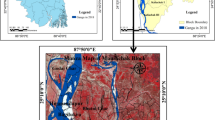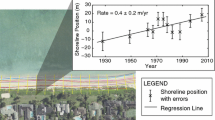Abstract
The significance of aeolian–fluvial interactions in controlling the geomorphology of the landscape in semi-arid desert dune fields has long been appreciated, but limited field data are available to examine how these modern aeolian–fluvial processes interact with the desert channel. In this study, based on desert channel changes and flash flood monitoring during a field survey, we characterize the responses of the desert channel to interactions between fluvial and aeolian processes in an ephemeral desert river in the ten kongduis region in the Hobq Desert in the Ordos Plateau (China). We find that the desert channel is the key place for interactions between aeolian and fluvial processes and has a significant impact on erosion and sediment yield. The pattern of aeolian–fluvial interactions in this area is that aeolian processes can move dunes and narrow the channels in the dry season, but storm floods can cause hyper-erosion of dune-covered banks and widen the channels, which are characterized by hyper-concentration flows during the flood season. Based on the cross-sections, the results show that the channel cross-section accretion area in the dry season was 0.4 times and 0.2 times the channel erosion area in the flood seasons of 2011 and 2012, respectively, of which the left bank accretion area in the dry season was 0.3 times and 0.1 times the left bank erosion in the flood seasons of 2011 and 2012, respectively. In the flood season, the dune-covered left bank erosion and sediment yield were 3.5 times those of the right bank on average. For channel lateral movement, the channel narrowing width caused by aeolian dune accretion in the dry season was 1/6 of the channel widening induced by storm-flood erosion in the flood season. Therefore, aeolian–fluvial interactions control the landform and landscape evolution in this desert area.










Similar content being viewed by others
References
Aich V, Zimmermann A, Elsenbeer H (2014) Quantification and interpretation of suspended-sediment discharge hysteresis patterns: how much data do we need? CATENA 122:120–129
Al-Masrahy MA, Mountney NP (2015) A classification scheme for fluvial–aeolian system interaction in desert-margin settings. Aeol Res 17:67–88
Andrews S (1981) Sedimentology of Great Sand Dunes, Colorado. In: Ethridge FG, Flores RM (eds) Recent and ancient nonmarine depositional environments. SEPM (Society for Sedimentary Geology), Tulsa, pp 279–291
Ardıçlıoğlu M, Kuriqi A (2019) Calibration of channel roughness in intermittent rivers using HEC-RAS model: case of Sarimsakli creek, Turkey. SN Appl Sci 1(9):1080
Bagnold RA (1936) The movement of desert sand. Geogr J 157(4):342–365
Belnap J, Munson SM, Field JP (2011) Aeolian and fluvial processes in dryland regions: the need for integrated studies. Ecohydrology 4(5):615–622
Bourke MC, Ewing RC, Finnegan D, Mcgowan HA (2009) Sand dune movement in the Victoria Valley, Antarctica. Geomorphology 109(3–4):148–160
Breshears DD, Whicker JJ, Johansen MP, Pinder JE (2003) Wind and water erosion and transport in semi-arid shrubland, grassland and forest ecosystems: quantifying dominance of horizontal wind-driven transport. Earth Surf Process Landf 28(11):1189–1209
Bullard JE, McTainsh GH (2003) Aeolian-fluvial interactions in dryland environments: examples, concepts and Australia case study. Prog Phys Geogr 27(4):471–501
Chen D, Wang Z, He Y (2002) Experimental study on the fluvial process of debris flow discharging into a river. J Sedim Res 6(3):22–28
Coppus R, Imeson AC (2002) Extreme events controlling erosion and sediment transport in a semi-arid sub-andean valley. Earth Surf Process Landf 27(13):1365–1375
Fan X, Shi C, Zhou Y, Shao W (2012) Sediment rating curves in the Ningxia-Inner Mongolia reaches of the upper Yellow River and their implications. Quat Int 282:152–162
Field JP, Breshears DD, Whicker JJ (2009) Toward a more holistic perspective of soil erosion: why aeolian research needs to explicitly consider fluvial processes and interactions. Aeol Res 1(1–2):9–17
Gao P (2008) Understanding watershed suspended sediment transport. Prog Phys Geogr 32:243–263
Gao P, Josefson M (2012) Event-based suspended sediment dynamics in a central New York watershed. Geomorphology 139–140:425–437
Gao P, Pasternack G (2007) Dynamics of suspended sediment transport at field-scale drain channels of irrigation-dominated watersheds in the Sonoran Desert, south-eastern California. Hydrol Process 21:2081–2092
Hollands CB, Nanson GC, Jones BG, Bristow CS, Price DM, Pietsch TJ (2006) Aeolian–fluvial interaction: evidence for Late Quaternary channel change and wind-rift linear dune formation in the northwestern Simpson Desert, Australia. Quat Sci Rev 25(1–2):142–162
Jones LS, Blakey RC (1997) Eolian-fluvial interaction in the Page Sandstone (Middle Jurassic) in south-central Utah, USA - a case study of erg-margin processes. Sedim Geol 109(1–2):181–198
Klein M (1984) Anti clockwise hysteresis in suspended sediment concentration during individual storms: Holbeck Catchment; Yorkshire, England. CATENA 11(2):251–257
Kuriqi A, Koçileri G, Ardiçlioğlu M (2020) Potential of Meyer-Peter and Müller approach for estimation of bed-load sediment transport under different hydraulic regimes. Model Earth Syst Environ 6(1):129–137. https://doi.org/10.1007/s40808-019-00665-0
Langford RP (1989) Fluvial-aeolian interactions: part I, modern systems. Sedimentology 36(6):1023–1035
Langford RP (2010) Aeolian-fluvial interactions: part I, modern systems. Sedimentology 36(6):1023–1035
Leopold LB, Wolman MG (1957) River channel patterns - braided, meandering and straight. Prof Geogr 9:39–85
Leopold LB, Wolman MG (1970) River channel patterns. Palgrave Macmillan
Li S, Dong G, Shen J, Yang P, Liu X, Wang Y, Jin H, Wang Q (1999) Formation mechanism and development pattern of aeolian sand landform in Yarlung Zangbo River valley. Sci Sin Terrae 42(3):272–284
Li Y, Wang H, Ma Q (2018) Responses of the braided channel to reduced discharge and lateral inputs of aeolian sand in the Ulan Buh Desert Reach of the Upper Yellow River. Environ Earth Sci 77(10):379
Liu B, Coulthard TJ (2015) Mapping the interactions between rivers and sand dunes: Implications for fluvial and aeolian geomorphology. Geomorphology 231:246–257
Loope DB, Swinehart JB, Mason JP (1995) Dune-dammed paleovalleys of the Nebraska Sand Hills: intrinsic versus climatic controls on the accumulation of lake and marsh sediments. Geol Soc Am Bull 107(107):396–0406
Lopez-Tarazon JA, Batalla RJ, Vericat D, Francke T (2009) Suspended sediment transport in a highly erodible catchment: the River Isábena (southern Pyrenees). Geomorphology 109:210–221
Mano V, Nemery J, Belleudy P, Poirel A (2009) Assessment of suspended sediment transport in four alpine watersheds (France): influence of the climatic regime. Hydrol Process 23:777–792
Maroulis JC, Nanson GC, Price DM, Pietsch T (2007) Aeolian–fluvial interaction and climate change: source-bordering dune development over the past ∼100 ka on Cooper Creek, central Australia. Quat Sci Rev 26(3–4):386–404
Mason JP, Swinehart JB, Loope DB (1997) Holocene history of lacustrine and marsh sediments in a dune-blocked drainage, Southwestern Nebraska Sand Hills, U.S.A. J Paleolimnol 17(1):67–83
Mountney N, Howell J, Flint S, Jerram D (1998) Aeolian and alluvial deposition within the Mesozoic Etjo Sandstone Formation, nortwest Namibia. J Afr Earth Sc 27(2):175–192
Reid I, Frostick LE (2011) Channel form, flows and sediments of endogenous ephemeral rivers in deserts. Arid zone geomorphology: process, form and change in drylands, Third Edition, pp 301–332
Rosgen DL (1994) A classification of natural rivers. CATENA 22(3):169–199
Rovira A, Batalla RJ (2006) Temporal distribution of suspended sediment transport in a Mediterranean basin: the lower Tordera (NE Spain). Geomorphology 79:58–71
Sankey JB, Draut AE (2014) Gully annealing by aeolian sediment: field and remote-sensing investigation of aeolian–hillslope–fluvial interactions, Colorado River corridor, Arizona, USA. Geomorphology 220:68–80
Sankey JB, Caster J, Kasprak A, East AE (2018) The response of source-bordering aeolian dunefields to sediment-supply changes 2: controlled floods of the Colorado River in Grand Canyon, Arizona, USA. Aeol Res 32:154–169
Sarma JN (2005) Fluvial process and morphology of the Brahmaputra River in Assam, India. Geomorphology 70(3–4):226–256
Schumm S (1985) Patterns of alluvial rivers. Annu Rev Earth Planet Sci 13:5
Seeger M, Errea M-P, Beguería S, Arnáez J, Martí C, García-Ruiz JM (2004) Catchment soil moisture and rainfall characteristics as determinant factors for discharge/suspended sediment hysteretic loops in a small headwater catchment in the Spanish Pyrenees. J Hydrol 288:299–311
Smith HG, Dragovich D (2009) Interpreting sediment delivery processes using suspended sediment-discharge hysteresis patterns from nested upland catchments, south-eastern Australia. Hydrol Process 23(17):2415–2426
Smith ND, Smith DG (1984) William River: an outstanding example of channel widening and braiding caused by bed-load addition. Geology 12(2):78–82
Ta W, Jia X, Wang H (2013) Channel deposition induced by bank erosion in response to decreased flows in the sand-banked reach of the upstream Yellow River. CATENA 105:62–68
Ta W, Wang H, Jia X (2014) Aeolian process-induced hyper-concentrated flow in a desert watershed. J Hydrol 511:220–228
Ta W, Wang H, Jia X (2015) The contribution of aeolian processes to fluvial sediment yield from a desert watershed in the Ordos Plateau, China. Hydrol Process 29(1):80–89
Tooth S (2000) Process, form and change in dryland rivers: a review of recent research. Earth Sci Rev 51(1–4):67–107
Trask ID (1932) Origin and environment of source sediments of petroleum. Gulf Pub. Co., p 323
Wang Y, Wu Y, Kou Q, Min D, Chang Y, Zhang R (2007) Definition of arsenic rock zone borderline and its classification. Sci Soil Water Conserv 5(01):14–18
Williams GP (1989) Sediment concentration versus water discharge during single hydrologic events in rivers. J Hydrol 111:89–106
Williams M (2015) Interactions between fluvial and eolian geomorphic systems and processes: examples from the Sahara and Australia. CATENA 134:4–13
Xu J (2014) The influence of dilution on downstream channel sedimentation in large rivers: the Yellow River, China. Earth Surface Process Landf 39(4):450–462
Yang G (2005) Symposia on blown-sand disaster. Ocean Press, Beijing (in Chinese)
Yang H, Shi C (2018) Spatial and temporal variations of aeolian sediment input to the tributaries (the Ten Kongduis) of the upper Yellow River. Aeol Res 30:1–10
Yang G, Liu Y, Shi P (1987) Discussion on Blown-sand along the Bank of Yellow River from Beichangtan to Hequ. J Desert Res 7(1):46–58
Yang G, Liu Y, Shi P (1988) Estimation of the infusion of blown-sand along the Bank into Yellow River. Chin Sci Bull 13:1017–1021
Yeshaneh E, Eder A, Blöschl G (2013) Temporal variation of suspended sediment transport in the Koga catchment, North Western Ethiopia and environmental implications. Hydrol Process 28(24):5972–5984
Acknowledgements
This work was supported by the National Key Research and Development Program of China (2016YFC0402401), Jiangsu Province High-level Innovative and Entrepreneurial Talent Introduction Program, Doctor of Innovative and Entrepreneurial (NO. (2020)31015), the opening Fund of Key Laboratory of Desert and Desertification, Chinese Academy of Sciences (KLDD-2017-001). We thank springer nature research editing service group (https://authorservices.springernature.cn/) for editing the language of this manuscript.
Author information
Authors and Affiliations
Corresponding author
Additional information
Publisher's Note
Springer Nature remains neutral with regard to jurisdictional claims in published maps and institutional affiliations.
Rights and permissions
About this article
Cite this article
Jia, X., Wang, H. & Li, Y. Desert channel erosion, accretion characteristics and their implications for aeolian–fluvial interactions: a case study in a desert watershed in the Ordos Plateau, China. Environ Earth Sci 80, 371 (2021). https://doi.org/10.1007/s12665-021-09656-w
Received:
Accepted:
Published:
DOI: https://doi.org/10.1007/s12665-021-09656-w




